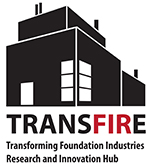Sustainability reporting is a vital tool to provide information on an organisations’ social, economic, and environmental performance and is an essential way for organisations to demonstrate accountability to their various stakeholders. But how do companies know which metrics or key performance indicators (KPIs) they should use?
The TransFIRe project through its different Work Streams (WS) is addressing the need of identifying the most suitable metrics for the foundation industries (FI), by looking at different levels for measuring and reporting performance, ranging from the process level to factory level and eventually to the “beyond the fence” level (a system view, looking from the perspective of external stakeholders, including the surrounding community, and the environment).

Figure 1 – Schematic representation of the different levels for measuring performance of FIs.
Process level metrics
At a process level, TransFIRe researchers have created a framework to help the manufacturing industries identify the right environmental KPIs on which to report. The developed method categorises and ranks KPIs and then allows for the selection of the most effective KPI in representing a specified target as well as identifying unmonitored environmental aspects.
A further study by the group aimed to evaluate the metrics for benchmarking energy utilisation within the foundation industries. This was done by deploying two surveys, aimed at industry and subject matter experts, to evaluate the commonly used metrics, in this instance, energy metrics.

Figure 2 – Survey results indicating industry responses to which metrics they used.
The survey results revealed a significant variability both within and across sectors, with some organisations employing a greater number of metrics, with others prioritising higher quality metrics with a greater number of criteria.
This variability poses challenges for comparing performance and benchmarking whilst highlighting the need for standardised metrics across industries. A confirmed set of metrics with a clear methodology for collection would enable consistent and reliable data, promoting transparency and facilitating industry comparisons. This would all help to drive progress towards sustainability and efficiency, benefiting decision-making and fostering innovation.
Factory level metrics
The TransFIRe workstreams also investigated a broad range of tools available for measuring industry performance at the factory level, looking at all processes in parallel.
After reviewing and analysing a long list of the measurement tools, these were whittled down to the five best. Each of these methods includes the three pillars of sustainability (economic, environment, social) and can be used at the nano, micro and meso levels. The selected tools are:
- Sustainable Circular Index (SCI)
- End of Life Best Practice Indicators (BPI)
- Circular Business Model Set of Indicators based on Sustainability (CBM-IS)
- Value-based Resource Efficiency Indicator (VRE)
- CE Building Scale
These tools have been designed to measure performance under the circularity concept and have been applied to a wide range of sectors. The specific value within the FIs context needs to be further explored, but they provide a good starting point for companies interested in measuring and communicating sustainability performance under the principles of circular economy.
To conclude this stage of analysis, TransFIRe researchers summarised all the relevant material into information sheets for each of these five tools and these can be used to help select the most appropriate tool for each sector.
In the pipeline
Moving forward, there will also be further work by TransFIRe researchers to investigate benchmarking metrics that can be used to assess a company’s performance in terms of CO2 emissions and energy intensity of the foundation industries. This analysis will enable us to determine the UK’s position relative to other countries and identify areas that require improvement or further research.
In addition, the next phase of investigation will be to search for a methodology that goes beyond the fence, providing a more holistic view that incorporates the needs of external stakeholders, including, for example, the achievement of UN Sustainable Development Goals or the need to report on climate related issues.
Talking about TransFIRe’s metrics work, Juan Ramon Candia, University of York, said:
“There is growing global support for enhanced transparency as a means of increasing the accountability of companies. We live in the era of Information Transparency!
At the same time, companies can substantially benefit from measuring key performance indicators, as this allows them to identify improvement opportunities.
Our goal is to provide to the foundation industries with valuable insights into the different approaches to selecting and monitoring KPIs to improve the company’s decision making and performance.
We also aim to show the new tendencies and expectations in relation to measuring and communicating performance to the wider community, or beyond the factory´s fence. “
For more information regarding using metrics for sustainability reporting, please contact Professor Peter Ball, peter.ball@york.ac.uk.
Report Authors:
- Peter Ball (University of York)
- Natanael Bolson (University of Cambridge)
- Juan-Ramón Candia (University of York)
- Ahmed Khalil (Exeter University)
- Shoaib Sarfraz (Cranfield University)
- Ziyad Sherif (Cranfield University)
- Anne Velenturf (University of Leeds)

